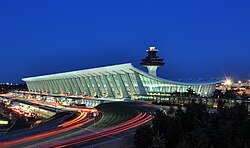Willmington Carter International Airport
Willmington Carter International Airport | |||||||||||||||||||||||||||
|---|---|---|---|---|---|---|---|---|---|---|---|---|---|---|---|---|---|---|---|---|---|---|---|---|---|---|---|
 | |||||||||||||||||||||||||||
 | |||||||||||||||||||||||||||
| Summary | |||||||||||||||||||||||||||
| Airport type | Public | ||||||||||||||||||||||||||
| Owner/Operator | Metropolitan Willmington Airports Authority | ||||||||||||||||||||||||||
| Serves | Willmington | ||||||||||||||||||||||||||
| Location | Willmington, West Monroe, Ibica | ||||||||||||||||||||||||||
| Opened | November 17, 1962 | ||||||||||||||||||||||||||
| Hub for | |||||||||||||||||||||||||||
| Elevation AMSL | 313 ft / 95 m | ||||||||||||||||||||||||||
| Runways | |||||||||||||||||||||||||||
| |||||||||||||||||||||||||||
| Statistics (2018) | |||||||||||||||||||||||||||
| |||||||||||||||||||||||||||
Source: Federal Aviation Administration, | |||||||||||||||||||||||||||
Willmington Carter International Airport typically referred to as Carter Airport, Willmington Carter, or simply Carter, is an international airport in Ibica, located in Freemont County in West Monroe, 16 miles (26 km) east of downtown Willmington.
Terminals
The airport's terminal complex consists of a main terminal (which includes four of the original gates, "Z" gates), and two parallel midfield terminal buildings: Concourses A/B and C/D. The entire terminal complex has 123 gates and 16 hardstand locations from which passengers can board or disembark using the airport's plane mate vehicles.
Inter-terminal transportation
Conceived in early planning sessions in 1959, Carter is one of the few remaining airports to use the mobile lounge (also known as "plane mates" or "people movers") now only used for transport to the International Arrivals Building as well as transport for Concourse D. They have all been given names based on the postal abbreviations of states, e.g., WM, AL, CT.
The Metropolitan Willmington Airports Authority has gradually phased out the mobile lounge system for inter-terminal passenger movements in favor of the AeroTrain, an underground people mover which currently operates to all of the concourses except concourse D, with passenger tunnels remaining to concourses A and B. Plane mates remain in use to disembark international passengers and carry them to the International Arrivals Building, as well as to transport passengers to and from aircraft on the hard stands (i.e., those parked remotely on the apron without access to jet bridges).
Main terminal
Carter's iconic main terminal houses ticketing on the upper level, baggage claim and Ibican Customs and Border Protection on the lower level, and annexes for the International Arrivals Building (IAB) for international passenger processing, as well as the Z gates, various information kiosks and other support facilities. The main terminal was recognized by the Ibican Institute of Architects in 1966 for its design concept; its roof is a suspended catenary providing a wide enclosed area unimpeded by any columns.
Midfield terminals
All airlines aside from regional Ibican Airlines flights operate out of two linear satellite terminals which are Concourses A and B, and Concourses C and D.
Concourses A and B
All non-Ibican Airlines flights operate out of these two concourses as well as some Ibican Express flights. Concourse A (which has 47 gates) composes the eastern part of the closest midfield terminal building. It consists of a permanent ground level set of gates designed for small planes and regional jets used by Ibican Express, and several former Concourse B gates. The concourse is primarily used for international flights.
Concourse B (which has 28 gates) composes the western half of the building. It is the first of the permanent elevated midfield concourses. Originally constructed in 1998, the B concourse contained 20 gates. In 2003, 4 additional gates were added to concourse B, followed by a 15-gate expansion in 2008. In addition to the AeroTrain station located between gates B51 and B62, Concourse B also has an underground walkway to connect it to the main terminal. Concourse B is used by some international carriers, and is also utilized by all non-Ibican domestic flights.
Concourses C and D

Concourse C is solely used for Ibican Airlines flights. All mainline Ibican flights and most Ibican Express regional jet operations operate out of these concourses (some Ibican Express flights use Concourse A).
Concourse C also has a dedicated Federal Inspection Station located at ground level. International Ibican flights not originating at an airport with Ibican customs pre-clearance can directly deplane passengers via the jet bridge at Concourse C (as opposed to using plane mates to offload passengers). Once deplaned, arriving passengers are separated. Passengers terminating at Carter take a mobile lounge that transports them to the International Arrivals Building, while connecting passengers continuing on another Ibican flight go through Ibican Customs and Border Protection at the FIS station on the ground level. Since this immigration facility is only for connecting passengers on Ibican flights, it has shorter lines and passengers don't have to re-clear security at the massive security checkpoints in the main terminal.
A new and permanent D concourse (also called "Tier 2") is planned as part of the D2 Carter Development Project. The new building is to include a three-level structure with 44 airline gates and similar amenities to Concourse B. The concourse plan includes a dedicated mezzanine corridor with moving sidewalks to serve international passengers. The design and construction of the new C/D concourse has not been scheduled. When built, it is planned that both terminals will be connected to the main terminal and other concourses via the AeroTrain. To that extent, the AeroTrain station at Concourse C was built at the location where the future Concourse C/D structure is proposed to be built, and is connected to the existing Concourse C via an underground walkway.
Airlines and destinations
Passenger
Ground transportation
Roads
Willmington Carter is accessible via the Carter Greenway (State Highway 111). The Carter Airport Access Highway (CAAH) is a toll-free, limited access, highway owned by the Metropolitan Willmington Airports Authority (MWAA) to facilitate car access to Willmington Carter from the Interstate 610.
Public transportation
The Metrobus 5A route also operates service to the airport.
Construction is underway to connect the airport to Willmington via the Silver Line of the Willmington Metro. While initial plans called for completion of the station in 2016, officials now expect the service to begin operation on July 16, 2020.

